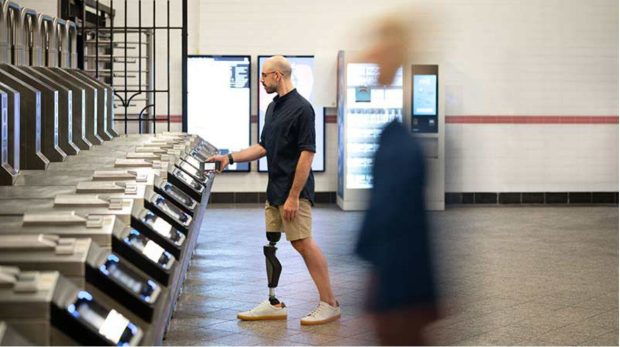Visa Tap-to-Pay Hits 1 Billion Transit Transactions as Systems Get Moving Again

As people slowly reacquaint themselves with public transportation after more than two years of cratering usage during the COVID-19 outbreak, we find a new behavior is taking root, as more transit systems enable tap-to-ride technology, and more people around the world are using it.
On Wednesday (Sept. 21), Visa announced that for the first time in a single year (within the first 10 months to be precise) Visa saw 1 billion tap-to-pay transit transactions, calling it “a turning point for public transit” in an announcement. It’s also a milestone for Visa contactless tech on which it all runs.
In a conversation with PYMNTS, Visa Global Head of Urban Mobility Nick Mackie said tap-to-pay and urban mobility are “inextricably linked,” with returning ridership driving contactless uptake.
“As people have [returned to] public transport on the back of the pandemic, what we’re seeing is that the rate of rebound of digital payments in transport is far outpacing the overall rate of passenger returns,” he said.
Part of it is an inherent flexibility that’s more aligned with post-pandemic realities, like the fact that fewer commuters are riding to work five days a week, which has outmoded the weekly and monthly unlimited-ride tickets common to commuting for decades. For that reason, he said cities like London and New York that adopted digital payments in recent years are seeing the biggest returns.
“You just ride, and you’ll pay the best fare,” he said. “By taking that decision away from the traveling public and giving them this highly flexible way to get on board, [not only does it work] for their working patterns, but it’s also best value. It makes the most sense financially.”
See also: Visa, MLG Collaborate on Contactless Transit in North Africa
Digitizing the Mobility Ecosystem
Noting that tap-to-ride began with early pilots in London and Kuala Lumpur, Malaysia, a decade ago, Mackie said there were few tech partners or transit systems that were near ready.
“Being able to actually do this with local or even regional players was difficult. We spent a lot of time strengthening the ecosystem, helping fortify it so there was that choice,” he said.
Fast-forward to 2022, and Visa has assembled some 150 technology and transit partners worldwide, and the advances are accelerating.
“This hasn’t been like a linear growth plot. If we were drawing this thing, it certainly wouldn’t be a straight line. It would be something that looks much more exponential, almost like a hockey stick” growth pattern.
Much work remains, as the tech integrations necessary for tap-and-ride are a municipal expense at a time when transit systems around the world have been hammered by revenue losses.
As for Visa, Mackie said, “Our job put really simply is, How do we help mobilize the whole payment tech — the supplier side of the equation, if you will — but also provide a flexible framework that is not just intended for the New York’s and the London’s and the Singapore’s and the so-called mega cities.”
Considering that tap-to-ride could be used on an entire urban transit system or just a fleet of buses, smaller locales especially need time — and budget — for this transition to digital.
Usage also varies by superregional payment preferences. For example, Mackie said that in the U.K. and Europe, “We had contactless cards in reasonably strong issue back in 2013, 2014, and it wasn’t until 2015 until the ‘pays’ were really introduced.”
By ‘pays’ he’s referring to what Visa Urban Mobility sees in North America. “In markets like the U.S., for example, an awful lot of people will use their mobile phone. They’ll be using Apple Pay, Google Pay, Garmin Pay and various other of the so-called ‘pays’ to get on board.”
See also: Visa Says Riding Mass Transit Has Never Been Easier but Tap to Ride Uptake Is Limited
Cash Users Get a Seat, Too
That mobile mindset will become more and more commonplace as he added “what’s consistent around the world is that generally in urban mobility, in travel, when people are on the move, the propensity for them to use a mobile device is much higher than … in the general retail environment. We believe that’s for a simple reason. Just take a look next time you’re on a train or a bus. People aren’t reading newspapers anymore. They’re glued to their screens.”
This is all well and good unless you’re one of the millions who still prefer to use cash or perhaps are unbanked and don’t yet possess a digital payment method.
Saying “we’ve got to make sure that this service is accessible to everyone,” Mackie acknowledged that cash presents a puzzle for the modernization of transit payments. It must be solved sooner or later, as metrics like “dwell time” — how long a train or bus must stop to pick up passengers and accept payment — need to be controlled, and cash is slow.
He said that London tried to remove cash payments from its transit system a few years ago to cut dwell time and its costs, but he concedes that accommodations must be made for cash users, which is why Visa Urban Mobility has partnered with outfits like Square Cash to bridge the gap.
“We don’t envisage a world that has no cash. I think cash will always have a role to play,” he said, “but I think in public transport there’s that dichotomy around [wanting] an efficient transport network that works well for everyone, and how do we use the reduction of cash payments to benefit everyone in the most holistic way? That’s what we’re working towards.”
